If you’re an RVer who lives in the US, you have an excellent opportunity to expand your travel destinations by taking RVing adventures across the northern border to Canada.
But, before you drive your motorhome or tow your travel trailer or fifth wheel to the border, you need to know how to prepare for taking your RV to Canada to make the crossing fast and efficient for you and the border agents.
Luckily, this guide to Canada RV border crossings gives you all the information you need, including what identity and RV ownership papers you’ll need, along with what personal belongings or foods are prohibited, and much more.
Taking an RV trip to Canada doesn’t have to be complicated, just read the guide below, make your plans, and get packing!
What You Need to Cross Your RV into Canada
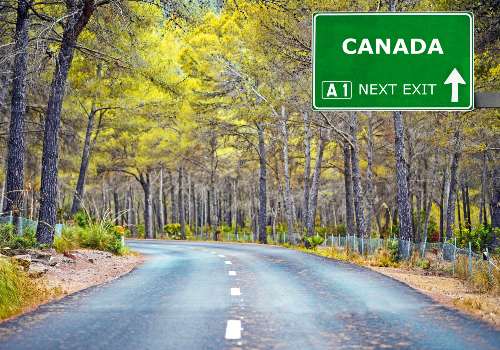
Crossing the border in your RV into Canada requires a number of things, and having all your documentation ready to go will expedite the process.
You also may need to allow border agents into your RV for an inspection and answer whatever questions they may have.
Don’t fear the agents. It’s their job to ensure the laws of Canada are followed, and you can have a safe trip, they are not out to ruin your vacation.
Necessary Documents to Cross into Canada in an RV
The following four items you must have ready to show border agents:
1 – Proof of Citizenship
All members of your RV traveling party will need to present proof of their US citizenship.
Acceptable documents are:
- A valid US passport, passport card, or NEXUS card
- An original birth certificate
- Original certificate of naturalization or citizenship
- A Certificate of Indian Status
- A US Permanent Resident Card
- Photo Identification
Children under 16 need proof of US citizenship but do not need to include photo identification.
2 – RV and Tow Vehicle Registration and Insurance
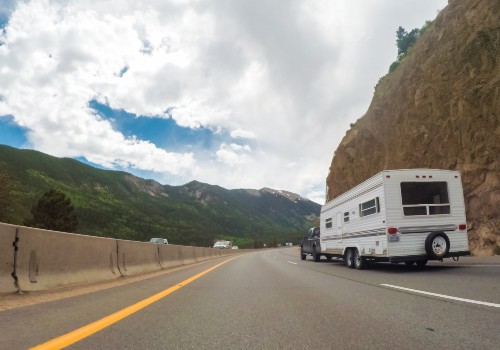
You’ll need to provide the recreational vehicle, tow vehicle, and toad (if you are pulling one with your motorhome) registration and proof of insurance paperwork to the border agents if they ask.
You should have a list of any RV or vehicle license plate numbers to save time filling out paperwork or if asked for that information.
3 – Explanation of Your Travel Plans
Expect to be asked why you are entering Canada, where you are going, and how long you plan on staying.
Be as thorough as possible with travel details, as it will help border agents feel more comfortable letting you pass versus being vague or even irritated about them questioning your plans.
If you have reservations at campgrounds or other attractions, have the paperwork on hand to show the agents.
If you are planning an extensive RV trip across Canada that exceeds 180 days, you’ll need to secure a travel visa first.
4 – Current Veterinary Documentation for Pets

If you are traveling into Canada with any pets, you’ll need to prove to the border agents they have a current rabies certificate and a signed veterinary statement.
Keep pet paperwork with your other personal documentation papers so you aren’t searching for them when you reach the Canadian border crossing.
What Items You CAN Bring into Canada in an RV
It’s often easy to forget what items you may have stashed away in your RV cabinets and storage compartments.
Since the last thing you want to happen is to have problems at the border because you have forbidden items that could get you in trouble or be confiscated, you need to clean out your camper.
Here are all the types of personal belongings and camping gear that you can bring into Canada when you cross the border in your RV:
PERSONAL BAGGAGE
Under this category falls:
- Clothing for all occupants
- Camping equipment
- Sports equipment
- Cameras
- Personal computers, cell phones, tablets, and their chargers or accessories
- Your recreational vehicle plus any tow vehicle
PET FOOD
For pet food, including treats, you must have unopened, commercially packaged bags or containers in their original containers. No bags of pet food can weigh over 44 pounds.
Toss or give away any opened pet food items long before you reach the border crossing to avoid issues.
MONEY
You can carry cash into and out of Canada, but if the amount is $10,000 or more when arriving or departing the country, you MUST report it to the CBSA (Canada Border Services Agency).
You make a report by either filling out a CBSA Declaration Card, verbally telling an agent at the border, using an Automated Border Clearance kiosk, or using a Primary Inspection Kiosk.
You can get more information about monetary reporting and all other current border-crossing regulations by visiting the Canada Border Services Agency website.
ALCOHOL
If you have alcohol in your RV when you reach the border to Canada, know that you will only be able to bring across:
- 24 bottles or cans of ale or beer
- One large standard bottle of liquor
- Two 750 ml bottles of wine
TOBACCO PRODUCTS
The limits for transporting tobacco products across the Canadian border include:
- 50 cigars
- No more than 200 cigarettes
- 7 ounces of manufactured tobacco
- No more than 200 tobacco sticks
PRESCRIPTION DRUGS
For anyone traveling in your recreational vehicle that takes prescription medication, expect to show border agents each person’s package of pills, liquids, inhalers, patches, or injectables in their original and properly labeled packaging.
Having a letter from the prescribing doctor detailing the medications and what they treat is not necessary but can be helpful if questions arise.
What Items You CANNOT Bring into Canada in an RV
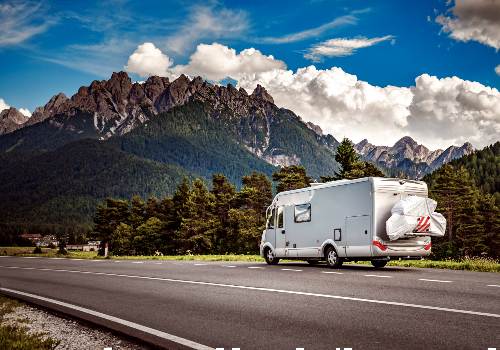
Canada prohibits certain items from crossing its borders to prevent the spread of diseases.
These items include:
- Plants
- Food including eggs, dairy products, and fresh fruits and vegetables
- Non-pet animals
- Animal-related products
If you have any above items in your recreational vehicle at the time of crossing, you MUST declare it to the border agents.
The agents will determine which, if any, of the declared items are permissible.
For example, they may allow some food items depending on the packaging, amount, or origin. You can find a list by the Canadian Food Inspection Agency that details what food from the US you can bring across in your RV.
However, the whole border crossing process will go much quicker if you clear your RV of forbidden or need-to-be-declared items and plan a trip to the grocery store once inside Canada.
FIREARMS and AMMUNITION and WEAPONS
You must declare any guns, knives, mace, tasers, pepper spray, or other weapons immediately when reaching Canada’s border port of entry.
FIREWORKS and EXPLOSIVES
You cannot bring fireworks or explosives of any sort across the Canadian border unless you have written authorization and permits from the appropriate authorities.
FIREWOOD
No firewood, sticks, or kindling can come across the Canada border in your camper to help prevent the spread of insects, diseases, or other pests.
What to Expect When You Reach a Canada Port of Entry
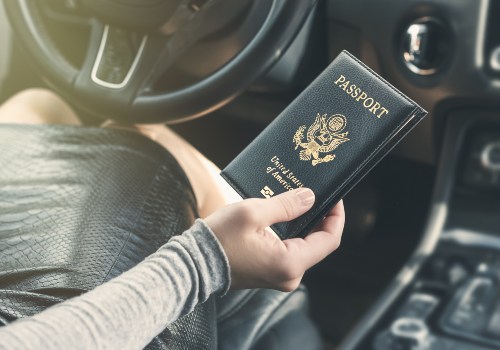
The first time you take your RV across the border, you may feel trepidation because you might hear horror stories from fellow travelers about the process.
To alleviate some of the stress of a Canada border crossing, understand that each person’s experience will differ.
The time it takes to clear the border depends on many factors, such as traffic levels when you reach the port of entry. In addition, if you declare items or have difficulty answering border agent questions, it may lead to a lengthy inspection of your RV.
Expect to hand over your identification and vehicle information and answer these questions:
- Who else is in the vehicle besides those they can see in the driver’s and passenger seats
- Do you have pets? If so, do you have their paperwork?
- Where are you from?
- Where are you going?
- How long do you plan to remain in Canada?
- Are you carrying any firearms or weapons?
Be concise yet friendly with your answers to keep the border-crossing process as short as possible. Once the agent feels your documents and answers are in order, they will return your paperwork, welcome you to Canada, and send you on your way.
How is Covid Affecting the Current Canada Border Crossings?

Want to Connect With a Community of Over 1,078 RV Enthusiasts?
Canadian land borders are currently operating at reduced capacity due to staffing issues and cautions in relation to the pandemic.
All travelers must use the ArriveCAN system and enter their traveler information, including proof of vaccination, before arriving in Canada. Visit CBSA for more details on land border crossings and Covid information, as there are continual updates.
Updates as of October 1st, 2022
Starting October 1, 2022, the following obligations will no longer apply to all travelers, irrespective of their nationality:
- The need to provide public health data through the ArriveCAN app or website;
- The requirement to demonstrate proof of vaccination;
- The necessity for pre-travel or upon arrival testing;
- The enforcement of COVID-19-related quarantine or isolation;
- The duty to track and report any potential signs or symptoms of COVID-19 after entering Canada.
In addition to this, Transport Canada is eliminating current travel prerequisites. Effective October 1, 2022, travelers will no longer be obligated to:
- Undergo health assessments for air and rail travel;
- Don masks on airplanes and trains.
Although the mask mandate is being withdrawn, all travelers are still highly encouraged to wear high-quality and properly fitted masks for the duration of their trips.
How Long Is the Wait to Cross the Canada Border?
The average wait time to clear a Canada border crossing is 45 minutes.
However, most crossings take less than ten minutes because they do not include a lengthy secondary inspection for persons or vehicles that raise concerns with the border agents.
Many less-traveled crossing points take only a few minutes, while those near major cities or highways will be more congested and take an hour or more, especially around holidays.
The Ambassador Bridge that connects Detroit, Michigan to Windsor, Ontario in Canada is the busiest border crossing of them all. The heavy traffic is due mainly to semi-trailers hauling goods across the bridge between the two countries.
The morning or late evening hours are the best time to cross the border to Canada as there is less traffic, with the lines growing the longest between 3 and 6 PM.
Best Tips for RV Travel in Canada
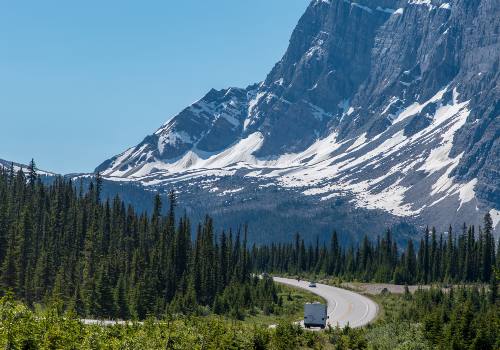
Once you get across the Canadian border, you’ll want the rest of your trip to be as enjoyable as possible.
By using the tips below for Canada RVing, you can help avoid issues that cause stress or put you in danger, so consider them when making travel plans.
Book Summer or Early Fall Travel in Advance
Whenever possible, try to book your Canada RV trip from July through October to ensure the best weather for camping.
Winter drags on from late fall through spring, so avoid those months when planning an RV trip unless you are a fan of cold-weather camping.
Another reason to book in the warmer months is that many campgrounds and RV parks in Canada close for the winter, which may leave you hunting for open campsites.
Most campgrounds or parks within Canada allow you to book a campsite up to five months in advance. So if you know when you plan to take your RV across the border into Canada, you can take advantage of the timeline and secure all your camping locations well before others who may wait until closer to their travel date.
Enjoy Free Parking Between Camping Destinations
About 89 percent of Canada is crown land, or public areas, where you can find many campgrounds, lots, or parks where you can park your RV overnight for free.
Check out Backroad Mapbooks and The Milepost on how to find free locations to park your RV across Canada.
Don’t Forget the Animals are Wild in Canada
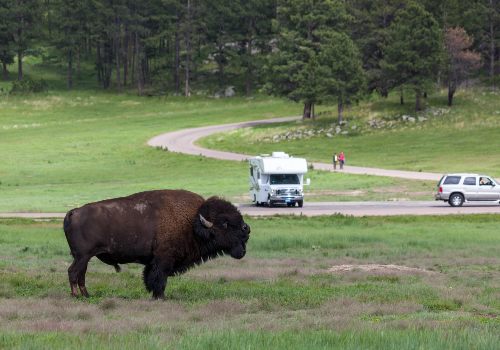
Canada has an abundance of elk, moose, bears, cougars, and other animals that you may see along the roads as you drive your RV, or while you are at your campsite.
Remember that these animals are wild, no matter how cute or docile they seem. Never try to get close to any animal for a better look or to take pictures, as they can suddenly attack leaving you seriously injured or even killed.
Don’t feed wild animals, never leave food out at your campsite, and always throw your trash in designated receptacles.
Final Thoughts
Canada is vast, enabling RVers countless years of exciting visits to take in the natural wonders, cultural experiences, and all the dining, attractions, and shopping you could ever want.
Crossing the border to Canada in an RV isn’t difficult when you know what to expect and have all your documents ready.
RV travel doesn’t need to stop at the US border. Expand your journeys to our friendly neighbors to the north, and use this guide to visit Canada in an RV to plan a quick and smooth border crossing.
Canada Border Crossing Tips (Video)
"Man cannot discover new oceans unless he has the courage to lose sight of the shore."
-- Andre Gide

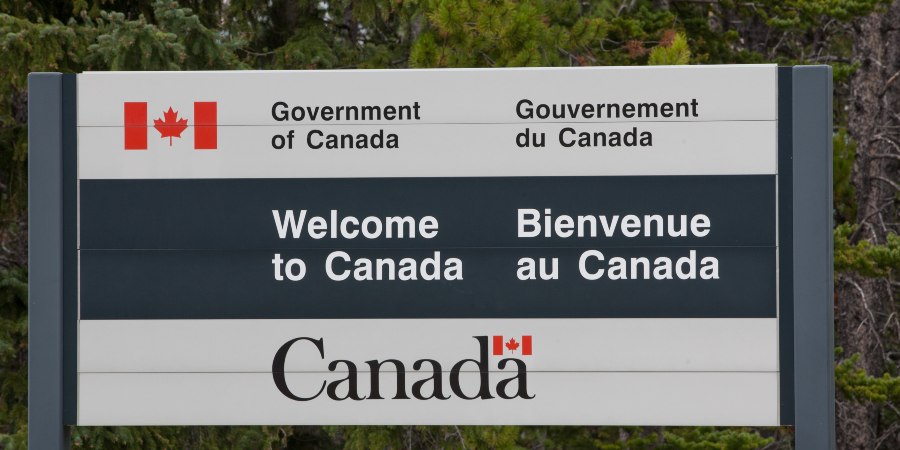
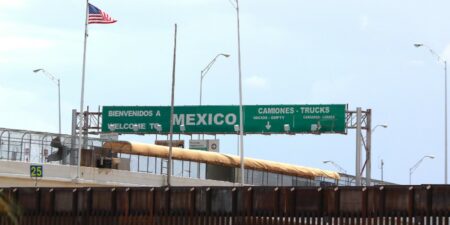
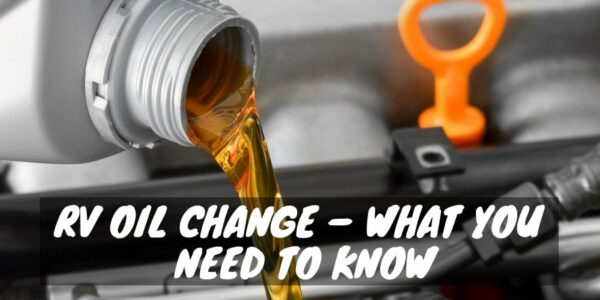

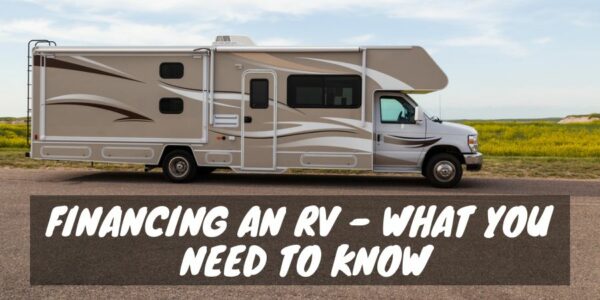






This is very informative & helpful. we did not know what to expect at the border.
I took notes & will continue to do research,
Thanks,
Diane
This is very helpful. Most of which I was aware, but nice to be reinforced. I have not crossed the border in an RV before. I traveled by car in October 2022 and the covid vaccine was NOT required anymore.
Need an updated video.
Effective October 1, 2022, all travellers, regardless of citizenship, will no longer have to:
Submit public health information through the ArriveCAN app or website;
Provide proof of vaccination;
Undergo pre- or on-arrival testing;
Carry out COVID-19-related quarantine or isolation;
Monitor and report if they develop signs or symptoms of COVID-19 upon arriving in Canada.
Transport Canada is also removing existing travel requirements. As of October 1, 2022, travellers will no longer be required to:
Undergo health checks for travel on air and rail; or
Wear masks on planes and trains.
Although the masking requirement is being lifted, all travellers are strongly recommended to wear high-quality and well-fitted masks during their journeys.
Thanks,Karen, much appreciated – I updated the article.